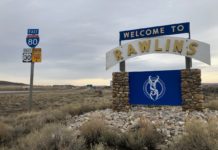May 18, 2022 |
During a one-hour presentation to Carbon County Commissioners earlier this month, a 33-year veteran of the U.S. Fish and Wildlife Service provided documented evidence of the deadly impacts of wind turbines on the golden eagle population in the Shirley Basin.
Mike Lockhart of Laramie is a research biologist who has conducted field studies on golden eagles and other raptors since 1972. Lockhart told county commissioners that he believes global warming is a real threat that needs to be addressed. However, the deadly impacts of green energy solutions, like wind power, on wildlife are largely ignored in the myopic rush to phase out fossil fuels.
Audio PlayerPhoto of an untagged eagle killed in August 2009 from Mike Lockhart’s presentation entitled “The Impacts of Existing and Proposed Wind Energy Projects on Golden Eagles in Albany and Carbon Counties, WY.” Photo by Mike Lockhart.
As part of his field research, Lockhart has captured a total of 176 golden eagles since 2014. He tagged 113 of them with satellite devices to track their movements across the western U.S. Of the 113, 80 were tagged on or adjacent to existing or proposed wind projects to document industrial impacts on the birds.
Lockhart said he collects downloads of the eagle activity on a daily basis. The data sets are large and complex. Lockhart is a one-man show so much of the scientific analysis has not been completed. One basic conclusion is inescapable, though.
Lockhart said the rapid development of turbines in the Shirley Basin is disrupting one of the most important wintering, migratory and nesting habitats that golden eagles have in the continental U.S.
Audio PlayerUsing photographs, maps and videos, Lockhart demonstrated how golden eagles that he has tagged use the Shirley Basin as a lay-over during their month long treks from the northern U.S. to Mexico every year.
Audio PlayerLockhart also uses the GPS tracking units to find eagles that have died from natural causes or otherwise. The wildlife biologist said mortality from other eagles in territorial battles is one of the lowest causes. Death by power line electrocution remains one of the highest. As the wind energy industry expands, turbine strikes are a growing cause of death, he said.
Audio PlayerLead poisoning is also a factor, especially for bald eagles which are more of a scavenger bird than golden eagles. Shooting birds remains a concern. One of the photographs in the presentation showed a golden eagle that was shot outside the town of Medicine Bow along a power line right of way in early June 2020. Lockhart had tagged the eagle one month earlier, on May 10th. Another photograph showed the carcass of a tagged eagle that had been shot in the Chokecherry area south of Rawlins in November of 2018.
Lockhart’s photo evidence also showed eagles that had been killed by turbine strikes in Carbon County. One was struck so violently, one of its wings was shorn off and the bird landed beyond the radius of the blades. Its GPS unit was undamaged and led to the discovery of the carcass, suggesting some struck birds may go undetected.
Audio PlayerLockhart said the evidence is still out on why eagles, which are intelligent and wary, are susceptible to turbine strikes. He speculated that golden eagles evolved to the “toughest thing in the air, and aren’t afraid of things.”
The bottom line of Lockhart’s presentation was that the agencies involved with protecting golden eagles and siting wind power installations are not doing due diligence because of a push by agency heads in Washington to push through green energy projects. He said two pending wind energy projects in the Shirley Basin, Blue Earth and Maestro, are in the midst of known nesting sites—spelling possible doom for the future of the birds.
Audio PlayerLockart concluded his presentation saying that wind energy development has moved too fast. The rapid growth of turbines on the landscape is outpacing any understanding of the harm they may be causing. Lockhart said the impacts of the existing turbine sites in Carbon and Albany Counties, combined with pending projects could “disastrous” consequences for golden eagles because the industry is overrunning critical habitat.
Audio PlayerThe commissioners were generally sympathetic to the issues Lockhart raised. Commissioner John Espy noted that a golden eagle nest that had been occupied on his ranch for many years is now empty. Commissioner Sue Jones said some residents of Medicine Bow who had supported wind energy development early on are now having second thoughts.
Audio PlayerCommission Chair John Johnson said Lockhart needed to take his power point presentation to policy makers in Cheyenne and Washington D.C. Johnson told Lockhart, “There’s a microphone in Congress, you need to be in front of it.”
Click here to view Mike Lockhart’s presentation entitled “The Impacts of Existing and Proposed Wind Energy Projects on Golden Eagles in Albany and Carbon Counties, WY.”
Related: WGFD gives update on study of wind energy impacts on antelope
















